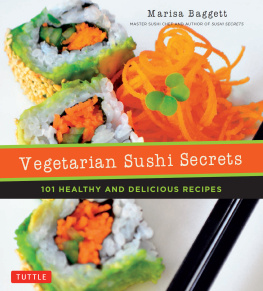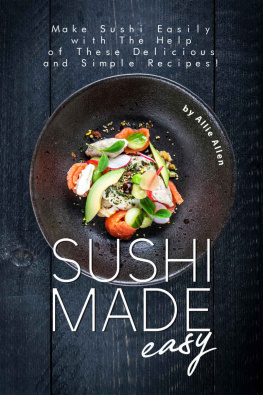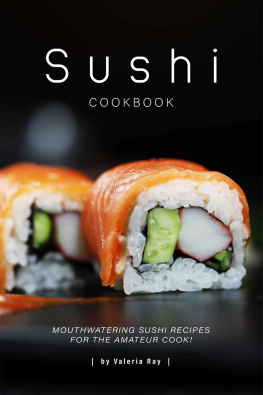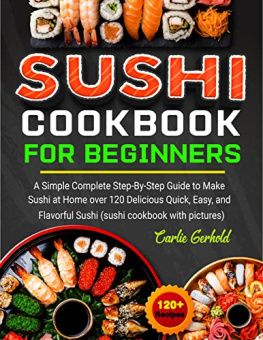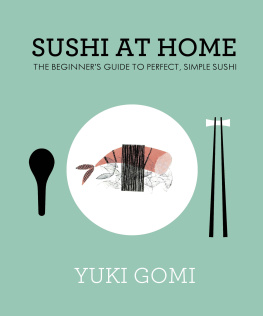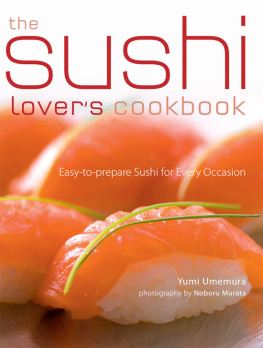A Passion for Sushi
Foreword by Allison Day

S ushi has been a part of my life as long as I can remember. My familys New Years Day tradition involved driving to the local Japanese restaurant to pick up a big order of sushi. For many years, this was the entire extent of my sushi experience.
Later, I started to slowly branch out with my sushi eating. The man I would go on to marry came up with the idea that I should start a food blogall about sushi.
Because I was a college student on a budget, a restaurant review blog was out of the question. I decided to first teach my readers how to make sushi, and then come up with all sorts of creative recipes for sushi. It was through this mutual passion for less traditional takes on sushi that Marisa and I found each other several years ago.
With all this sushi making at home, it wasnt long before I took over my familys New Years sushi duty, making dozens of different rolls every New Years morning. Sushi became my go-to contribution to potlucks, which led to experimentation in meat- and fish-free rolls for my vegetarian friends. Ive added tempura-fried and grilled vegetables to maki rolls, topped inari sushi with mushrooms, and even made a roll with hummus and bell peppers. While most people may automatically associate sushi with raw fish, Ive found it to be an excellent format for vegetable-based rolls as well.
Over the years, all this sushi-making led to an interest in developing sushi recipes that even the most sushi-averse would enjoy, as well as a passion for sustainability in sushi. These interests are two very big reasons why Im so excited for Vegetarian Sushi Secrets . Marisa and I share a passion for feeding people and showing them just how delicious sushi can be. And what better way to promote sustainability than to prove that sushi can be crave-worthy even in the absence of fish?
To have an entire cookbook full of delicious vegetarian options is beyond exciting for me. At first glance, Im already making a mental list of all the recipes I want to try, and then introduce to my vegetarian friends.
If youre new to sushi, the inari and nigiri section (page ) is a great place to start. In Japan, inari is the kids meal of sushi, which means its great for beginners. (And to be honest, many peopleincluding myselfremain big fans of inari sushi well into adulthood!) As for nigiri, its simply a ball of rice topped with somethingin this case, vegetables or a slice of Japanese-style omelette. If youre hesitant about the seaweed aspect, as many people are, this is a great way to ease yourself into the world of sushi.
For those more familiar with Americanized sushi rolls, Marisa has created tasty vegetarian versions of all your favorites. From Spider Rolls made with mushrooms to Dynamite Rolls with tofu, to Caterpillar Rolls with her Vegetarian Eel Sauce, and even a vegetarian version of the classic California Roll, the best-known American takes on sushi make a great vegetarian showing in this cookbook.
One of the things I love most about Marisa, as evidenced beautifully by both of her cookbooks, is that she isnt afraid to get creative with sushi while still staying true to the traditional techniques and spirit. Whether youre strictly vegan, wanting to eat more sustainably, or just trying to get more vegetables in your life, theres something for everyone in this cookbook!

Allison Day
author of Sushi Day blog
Acknowledgment
Raise a glass for my dearest Stan, who endured yet another many months of the lovely mixed smell of rice vinegar and freshly brewed coffee each morning. LChaim!

Chapter
SOUPS & APPETIZERS
For sushi lovers, it may be easy to imagine a meal made entirely of neatly enclosed bites of tangy rice studded with vegetable delights. However, all great sushi experiences begin with something to excite the taste buds. Soups and appetizers should be considered in your overall sushi meal plan to create a more balanced meal. A bowl of soup can warm the belly and open the palate. Tasty morsels of appetizers are often the first glimpse of more good things to come. Practically speaking, a first course also can serve as a way to keep hunger at bay while the sushi is being prepared.
One soup for sipping, served along with one or two appetizers, is generally a good approach to balancing a sushi meal. Let the seasons be your guide if selecting a first course feels daunting. Miso Soup and Soba Noodle Soup are year-round staples that feel appropriate despite the outside temperature. Cold Tofu Trio and Spaghetti Squash Somen are a refreshing cool start to help temper the heat of summer. Warm up the briskness of autumn with a bowl of Clear Soup with Pumpkin Dumplings or Dengaku. Choices for the start of the meal should also balance the sushi in terms of preparation. When preparing sushi with more complex steps, opt for starters that require the simplest preparation methods. If sushi preparation is straightforward, a starter with more involved steps will not feel overly cumbersome.
Vegetable Tempura
When making tempura, you must be mindful not only of the temperature of the oil, but also that of the batter and vegetables. Use a deep-fryer thermometer to make sure the oil stays between 335F (168C) and 350F (175C) to prevent sogginess. Meanwhile, keep the batter cold to produce a lacy and light coating. Vegetables should be at room temperature to minimize the drop in oil temperature when frying.
Prep Time: 15 minutes
Cook Time: About 2 minutes per piece
Makes 46 appetizer servings
Vegetables
small yellow onion, peeled
2 Japanese eggplants
8 shiitake mushroom caps
8 oz (250 g) asparagus, blanched
8 slices lotus root, peeled and blanched
1 small carrot, peeled and cut into 2-in (5-cm) lengths
avocado, cut into 8 wedges
8 shiso (perilla) leaves
Vegan Tempura Batter
cup (75 g) all-purpose flour
cup (75 g) potato starch or cornstarch (corn flour), plus more for dusting
1 cup (125 ml) cold carbonated water
Pinch of salt
Handful of ice cubes
Oil for frying
1 teaspoon grated ginger
1 teaspoon grated daikon radish
Tempura Dipping Sauce (page ), if desired
Insert toothpicks or short skewers through the onion at inch (6 mm) intervals. Cut the onion into slices between the toothpicks or skewers. Set aside.
Cut each Japanese eggplant in half lengthwise. Make three long cuts in each half to produce a fan shape. Set aside.
Use a sharp knife to remove a crosshatch section from the top of each shiitake mushroom cap. Set aside.
Have all other vegetables ready. Heat at least 2 inches of oil in a skillet or wok to 350F (175C).
Make the tempura batter: In a small bowl, stir together the flour, potato starch, carbonated water, and salt. Add the ice cubes. The batter will be thin.
Dredge three or four vegetable pieces in potato starch and shake off the excess.
Dip the vegetable pieces into the cold batter. You should still be able to see the vegetables through the batter.
Gently slide the dipped vegetables into the hot oil. Be careful not to drop ice into the hot grease. Fry until crisp, about 2 minutes. The eggplants will need to be flipped over and fried for about 2 minutes more.

